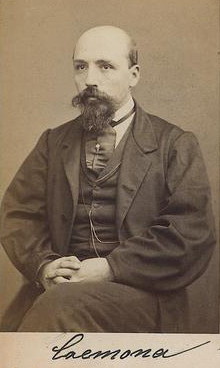Luigi Cremona facts for kids
Quick facts for kids
Luigi Cremona
|
|
|---|---|
 |
|
| Born | 7 December 1830 |
| Died | 10 June 1903 (aged 72) |
| Nationality | Italian |
| Alma mater | University of Pavia |
| Known for | Algebraic curve |
| Scientific career | |
| Fields | Mathematics |
| Institutions | University of Rome |
| Doctoral advisor | Francesco Brioschi |
| Doctoral students | Giuseppe Veronese |
Antonio Luigi Gaudenzio Giuseppe Cremona (born December 7, 1830 – died June 10, 1903) was a famous Italian mathematician. He spent his life studying geometry and improving how advanced mathematical teaching was done in Italy. He worked a lot on algebraic curves and surfaces. He also helped start the important Italian school of algebraic geometry.
Contents
Luigi Cremona's Early Life
Luigi Cremona was born in Pavia, a city in Lombardy. At that time, this area was part of the Austrian Empire. His younger brother, Tranquillo Cremona, became a painter.
In 1848, when he was just seventeen, Luigi joined Italian volunteers. They were fighting for Italy's freedom against Austria. He kept fighting until 1849, when the war ended.
After the fighting, he went back to Pavia. He studied at the university there with Francesco Brioschi. Luigi decided he wanted to be a math teacher. In 1853, he earned his degree in civil engineering and architecture.
Making Math Better in Italy
Luigi Cremona played a very important role in making big improvements in geometry in Italy. At the start of the 1800s, Italy was not very strong in mathematics. But by the end of the century, Italy was a leader in geometry. This was largely thanks to Cremona's work.
He helped change the secondary schools in Italy. He became a leader in how math should be taught. He also helped advance new math knowledge. Cremona, along with Brioschi and Beltrami, guided Italy's progress in math from the mid-1800s.
Teaching and Awards
Cremona's first job was teaching basic math in Cremona, then later in Milan. In 1860, he became a professor of higher geometry at the University of Bologna. In 1866, he moved to Milan to teach higher geometry and graphical statics.
That same year, he won a big award called the Steiner Prize. This prize was from the Prussian Academy of Sciences in Berlin. He shared the award for his paper on "surfaces of the third order." Two years later, he won the same prize again, this time all by himself.
From 1856, Cremona started writing for important math journals. He later became an editor for some of them. His papers appeared in math magazines in many countries. He also wrote several important books. Many of his books were translated into other languages. For example, his books Graphical Statics and Elements of Projective Geometry were published in English.
Later Career and Recognition
In 1873, Cremona was asked to come to Rome. He helped set up the Royal College of Engineering there. He also became a professor of higher mathematics at the University of Rome.
By this time, people all over Europe knew about Cremona. In 1879, he became a member of the Royal Society, a very important group of scientists in London. In the same year, he joined the senate of the Kingdom of Italy. This meant he was part of the government. In 1898, he was briefly the minister for education.
The Royal Swedish Academy of Sciences chose Cremona as a member in 1901. The next year, he received a German award called the Pour le Mérite for Sciences and Arts.
Luigi Cremona passed away in Rome in 1903.
See also
 In Spanish: Luigi Cremona para niños
In Spanish: Luigi Cremona para niños
- Cardioid
- Cremona diagram
- Cremona group
- Cremona–Richmond configuration
- Maxwell–Cremona correspondence
- Truss

